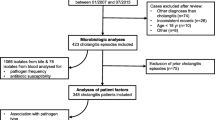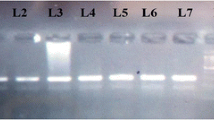Abstract
The biliary tract is normally sterile, but bile-tolerant bacteria are frequently isolated from patients with cholecystitis. Since the identification of about 25 Helicobacter species, some of which may grow in bile, studies have addressed the role of these organisms in primary biliary cirrhosis, primary sclerosing cholangitis, and cholelithiasis. Most of these bacteria show the presence of Helicobacter DNA or antigens in the bile tract and in liver samples. Altogether, data from studies on biliary and hepatic diseases, as well as pancreatic disorders, suggest that bile-tolerant Helicobacter species may induce a chronic infection with possible malignant transformation.
Similar content being viewed by others
References and Recommended Reading
Wetter LA, Hamadeh RM, Griffiss JM, et al.: Differences in outer membrane characteristics between gallstone-associated bacteria and normal bacterial flora. Lancet 1994, 343:444–448.
Monstein H-J, Jonsson Y, Zdolsek J, Svanvik J: Identification of Helicobacter pylori DNA in human cholesterol gallstones. Scand J Gastroenterol 2002, in press. H. pylori DNA was identified in pigmented gallstones using pyrosequencing, which confirms findings in similar studies using PCR and sequencing.
Levett PN: Leptospirosis. Clin Microbiol Rev 2001, 14:296–326.
Rubin RH: Infectious disease problems. In Transplantation of the Liver, edn 3. Edited by Maddrey WC, Schiff ER, Sorrell MF. Philadelphia: Lippincott Williams & Wilkins; 2001:275–296.
Haydon GH, Neuberger J: PBC: an infectious disease? Gut 2000, 47:586–588.
Van Velkinburgh JC, Gunn JS: PhoP-PhoQ-regulated loci are required for enhanced bile resistance in Salmonella spp. Infect Immun 1999, 67:1614–1622.
Wadström T, Hänninen M-L: Other Helicobacters in the digestive tract. Curr Opin Gastroenterol 1999, 1(suppl 15):S53-S66.
Fox JG, Schauer DB, Wadström T: Enterohepatic Helicobacter spp. Curr Opin Gastroenterol 2001, 17:S28-S31.
O‘Rourke J, Grehan M, Lee A: Non-pylori Helicobacter species in humans. Gut 2001, 49:601–606. Discussion of published data on the detection of non-H. pylori species in human disease. H. heilmannii and H. felis are associated with gastric infection and MALT lymphoma, although the former causes a less aggressive disease than H. pylori. H. cinaedi and H. fennelliae are implicated in human intestinal disease, and most likely also H. canadensis, H. rappini, H. heilmannii, and H. pullorum. Data conflict regarding detection of Helicobacter DNA in biliary disease, but data from patients with primary hepatic and biliary cancers are unequivocal.
Bulajic MM, Jovanovic IR, Loehr M: Helicobacter pylori infection in patients with bile duct malignancies. Gut 2000, 47:A90.
Harada K, Ozaki S, Kono N, et al.: Frequent molecular identification of Campylobacter but not Helicobacter genus in bile and biliary epithelium in hepatolithiasis. J Pathol 2001, 193:218–223.
Fox JG, Dewhirst FE, Shen Z, et al.: Hepatic Helicobacter species identified in bile and gallbladder tissue from Chileans with chronic cholecystitis. Gastroenterology 1998, 114:755–763.
Fox JG, Tully JG, Dewhirst FE: Helicobacter hepaticus sp nov, a microaerophilic bacterium isolated from livers and intestinal mucosal scrapings from mice. J Clin Microbiol 1994, 32:1238–1245.
Fox JG, Yan LL, Dewhirst FE, et al.: Helicobacter bilis sp. nov., a novel Helicobacter species isolated from bile, livers, and intestines of aged, inbred mice. J Clin Microbiol 1995, 33:445–454.
Lin T-T, Yeh C-T, Wu C-S, Liaw Y-F: Detection and partial sequence analysis of Helicobacter pylori DNA in the bile samples. Dig Dis Sci 1995, 40:2214–2219.
Figura N, Cetta F, Angelico M, et al.: Most Helicobacter pylori-infected patients have specific antibodies, and some also have H. pylori antigens antigens and genomic material in bile. Is it a risk factor for gallstone formation? Dig Dis Sci 1998, 43:854–862.
Nilsson H-O, Castedal M, Olsson R, Wadström T: Detection of Helicobacter in the liver of patients with chronic cholestatic liver diseases. J Physiol Pharmacol 1999, 50:875–881.
Nilsson H-O, Taneera J, Castedal M, et al.: Identification of Helicobacter pylori and other Helicobacter sp by PCR, hybridization and partial DNA sequencing in human liver samples from patients with primary sclerosing cholangitis or primary biliary cirrhosis. J Clin Microbiol 2000, 38:1072–1076. DNA from H. pylori, H. suis, and "Helicobacter liver" was detected in patients with malignant biliary disease.
Fox JG, Handt L, Sheppard BJ, et al.: Isolation of Helicobacter cinaedi from the colon, liver, and mesenteric lymph node of a Rhesus monkey with chronic colitis and hepatitis. J Clin Microbiol 2001, 39:1580–1585. This study suggests translocation of H. cinaedi from the intestine to the liver via mesenteric lymph nodes in Rhesus monkeys, with presumable implications for humans.
Stanley J, Linton D, Burnens AP, et al.: Helicobacter pullorum sp. nov.: genotype and phenotype of a new species isolated from poultry and from human patients with gastroenteritis. Microbiology 1994, 140:3441–3449.
Taylor NS, Fox JG, Yan L: In vitro hepatotoxic factor in Helicobacter hepaticus, H. pylori and other Helicobacter species. J Med Microbiol 1995, 42:48–52.
Ghiara P, Marchetti M, Blaser MJ, et al.: Role of the Helicobacter pylori virulence factors vacuolating cytotoxin, CagA, and urease in a mouse model of disease. Infect Immun 1995, 63:4154–4160.
Avenaud P, Marais A, Monteiro L, et al.: Detection of Helicobacter species in the liver of patients with and without primary liver carcinoma. Cancer 2000, 89:1431–1439. DNA from H. pylori and "Helicobacter liver" with close similarity to H. pylori was detected by PCR.
Nilsson H-O, Mulchandani R, Tranberg K-G, et al.: Helicobacter species identified in human livers from patients with cholangio-and hepatocellular carcinoma. Gastroenterology 2001, 120:323–324. H. pylori and "Helicobacter liver" were detected in patients with cholangio-and hepatocellular carcinoma, but not in patients with liver metastases from colorectal carcinoma.
Stoltzenberg-Solomon RZ, Blaser MJ, Limburg PJ, et al.: Helicobacter pylori seropositivity as a risk factor for pancreatic cancer. J Natl Cancer Inst 2001, 93:937–941. The first serologic evidence of H. pylori in pancreatic malignancy is reported here. This finding should be investigated further.
Franklin CL, Beckwith CS, Livingston RS, et al.: Isolation of a novel Helicobacter species, Helicobacter cholecystus sp. nov., from the gallbladders of Syrian hamsters with cholangiofibrosis and centrilobar pancreatitis. J Clin Microbiol 1996, 34:2952–2958.
Fox JG, Drolet R, Higgins R, et al.: Helicobacter canis isolated from a dog liver with multifocal necrotizing hepatitis. J Clin Microbiol 1996, 34:2479–2482.
Eaton KA, Dewhirst FE, Paster BJ, et al.: Prevalence and varieties of Helicobacter species in dogs from random sources and pet dogs: animal and public health implications. J Clin Microbiol 1996, 34:3165–3170.
Hirayama F, Takagi S, Yokoyama Y, et al.: Establishment of gastric Helicobacter pylori infection in Mongolian gerbils. J Gastroenterol 2001, 31:24–28.
Saunders KE, Shen Z, Dewhirst FE, et al.: Novel intestinal Helicobacter species isolated from cotton-top tamarins (Saguinus oedipus) with chronic colitis. J Clin Microbiol 1999, 37:146–151.
Schwan WR, Huang X-Z, Kopecko DJ: Differential bacterial survival, replication, and apoptosis-inducing ability of Salmonella serovars within human and murine macrophages. Infect Immun 2000, 68:1005–1013.
Marangoni A, Aldini R, Sambri V, et al.: Uptake and killing of Leptospira interrogans and Borrelia burgdorferi, spirochetes pathogenic to humans, by reticuloendothelial cells in perfused rat liver. Infect Immun 2000, 68:5408–5411.
Borén T, Wadström T, Normark S, et al.: Methods for the identification of Helicobacter pylori host receptors. In Methods of Molecular Medicine: Helicobacter pylori. Edited by Clayton CL, Mobley HLT. Totowa, NJ: Humana Press; 1997:205–224.
Whary MT, Morgan TJ, Dangler CA, et al.: Chronic active hepatitis induced by Helicobacter hepaticus in the A/JCr mouse is associated with a Th1 cell-mediated immune response. Infect Immun 1998, 66:3142–3148.
Garewal HS: Antioxidants and Disease Prevention. Boca Raton: CRC Press; 1997.
Phull PS, Price AB, White KL, et al.: Gastroduodenal mucosal Vitamin C levels in Helicobacter pylori infection. Scand J Gastroenterol 1999, 34:361–366.
Chin EY, Dangler CA, Fox JG, Schauer DB: Helicobacter hepaticus infection triggers inflammatory bowel disease in T cell receptor alpha, beta mutant mice. Comp Med 2000, 50:586–594.
Chmiela M, Czkwianianc E, Wadström T, Rudnicka W: Role of Helicobacter pylori surface structures in bacterial interaction with macrophages. Gut 1997, 40:20–24.
Pope LM, Reed KE, Payne SM: Increased protein secretion and adherence to HeLa cells by Shigella spp. following growth in the presence of bile salts. Infect Immun 1995, 63:3642–3648.
Erbil Y, Berber E, Özarmagan S, et al.: The effects of sodium deoxycholate, lactulose and glutamine on bacterial translocation in common bile duct ligated rats. Hepatogastroenterology 1999, 46:2791–2795.
Nilsson I, Lindgren S, Eriksson S, Wadström T: Serum antibodies to Helicobacter hepaticus and Helicobacter pylori in patients with chronic liver disease. Gut 2000, 46:410–414. The authors report on serologic detection of antibodies to H. hepaticus and H. pylori in patients with cirrhosis and different chronic liver diseases.
Wadström T, Ljungh Å, Willén R: Primary biliary cirrhosis and primary sclerosing cholangitis are of infectious origin! Gut 2001, 49:454. Spiral and coccoid forms of H. pylori and other Helicobacter species were visualized in portal zones in a patient with PSC.
Meining A, Kroher G, Stolte M: Animal reservoirs in the transmission of Helicobacter heilmannii: results of a questionnairebased study. Scand J Gastroenterol 1998, 33:795–798.
On SL: Taxonomy of Campylobacter, Arcobacter, Helicobacter and related bacteria: current status, future prospects and immediate concerns. Symp Ser Soc Appl Microbiol 2001, 90:1–15.
Barer MR, Gribbon LT, Harwood CR, Nwoguh CE: The viable but non-culturable hypothesis and medical bacteriology. Rev Med Microbiol 1993, 4:183–191.
Nilsson H-O, Blom J, Al-Soud WA, et al.: Effect of cold starvation, acid stress and nutrient stimuli on metabolic activities and morphology of Helicobacter pylori. Appl Environ Microbiol 2002, 68:11–19.
de Magalhaes Queiroz D, Santos A: Isolation of a Helicobacter strain from the human liver. Gastroenterology 2001, 121:1023–1024. Helicobacter species organisms were isolated from a patient with Wilson’s disease (related to copper overload). Further studies are needed to elucidate the possible pathogenetic role of Helicobacter in Wilson’s disease, which could lead to a change in current treatment schedules.
de Groote D, Ducatelle R, van Doorn LJ, et al.: Detection of ‘Candidatus Helicobacter suis’ in gastric samples of pigs by PCR: comparison with other invasive diagnostic techniques. J Clin Microbiol 2000, 38:1131–1135.
Author information
Authors and Affiliations
Rights and permissions
About this article
Cite this article
Ljungh, Å., Wadström, T. The role of microorganisms in biliary tract disease. Curr Gastroenterol Rep 4, 167–171 (2002). https://doi.org/10.1007/s11894-002-0055-6
Issue Date:
DOI: https://doi.org/10.1007/s11894-002-0055-6




